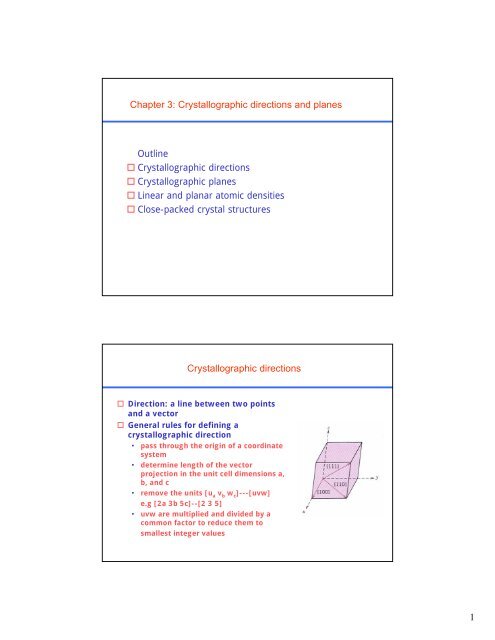1 Chapter 3: Crystallographic directions and planes Outline ...
1 Chapter 3: Crystallographic directions and planes Outline ...
1 Chapter 3: Crystallographic directions and planes Outline ...
Create successful ePaper yourself
Turn your PDF publications into a flip-book with our unique Google optimized e-Paper software.
<strong>Chapter</strong> 3: <strong>Crystallographic</strong> <strong>directions</strong> <strong>and</strong> <strong>planes</strong><br />
<strong>Outline</strong><br />
<strong>Crystallographic</strong> <strong>directions</strong><br />
<strong>Crystallographic</strong> <strong>planes</strong><br />
Linear <strong>and</strong> planar atomic densities<br />
Close-packed crystal structures<br />
<strong>Crystallographic</strong> <strong>directions</strong><br />
Direction: a line between two points<br />
<strong>and</strong> a vector<br />
General rules for defining a<br />
crystallographic direction<br />
• pass through the origin of a coordinate<br />
system<br />
• determine length of the vector<br />
projection in the unit cell dimensions a,<br />
b, <strong>and</strong> c<br />
• remove the units [u a<br />
v b<br />
w c<br />
]---[uvw]<br />
e.g [2a 3b 5c]--[2 3 5]<br />
• uvw are multiplied <strong>and</strong> divided by a<br />
common factor to reduce them to<br />
smallest integer values<br />
1
<strong>Crystallographic</strong> <strong>directions</strong> (continue)<br />
• denote the direction by [uvw]<br />
• family direction , defined by transformation<br />
• material properties along any direction in a family are the<br />
same, e.g. [100] [100] [010] in simple cubic are same.<br />
• for uniform crystal materials, all parallel <strong>directions</strong> have the<br />
same properties<br />
• negative index: a bar over the index<br />
Determine a direction<br />
Examples<br />
Determining the indices of line <strong>directions</strong><br />
2
Examples<br />
Sketch the following <strong>directions</strong> : [110], [-1-21], [-1 0 2]<br />
Hexagonal crystal<br />
4-index, or Miller-Bravais,<br />
coordinate system<br />
Conversion from 3-index to 4-index<br />
system<br />
3
Hexagonal crystal (continue)<br />
Convert [100] direction into the four- index Miller-Bravais<br />
scheme for hexagonal unit cells.<br />
<strong>Crystallographic</strong> <strong>planes</strong><br />
Orientation representation (hkl)--Miller indices<br />
Parallel <strong>planes</strong> have same miller indices<br />
Determine (hkl)<br />
• A plane can not pass the chosen origin<br />
• A plane must intersect or parallel any axis<br />
• If the above is not met, translation of the plane or origin is<br />
needed<br />
• Get the intercepts a, b, c. (infinite if the plane is parallel to an<br />
axis)<br />
• take the reciprocal<br />
• smallest integer rule<br />
(hkl) // (hkl) in opposite side of the origin<br />
For cubic only, plane orientations <strong>and</strong> <strong>directions</strong> with same<br />
indices are perpendicular to one another<br />
4
<strong>Crystallographic</strong> <strong>planes</strong> (continue)<br />
Figure 3.8<br />
<strong>Crystallographic</strong> <strong>planes</strong> (continue)<br />
Determine Miller indices of <strong>planes</strong><br />
5
<strong>Crystallographic</strong> <strong>planes</strong> (continue)<br />
Determine Miller indices of <strong>planes</strong><br />
<strong>Crystallographic</strong> <strong>planes</strong> (continue)<br />
Determine Miller indices of <strong>planes</strong><br />
6
<strong>Crystallographic</strong> <strong>planes</strong> (continue)<br />
Construct <strong>planes</strong> by Miller indices of <strong>planes</strong> (0 -1 -1) <strong>and</strong><br />
(1 1 -2)<br />
Atomic arrangements<br />
The atomic arrangement for a crystallographic plane<br />
depends on the crystal structure<br />
FCC: (a) reduced sphere<br />
(b) atomic packing of<br />
an FCC (110) plane<br />
BCC: (a) reduced sphere<br />
(b) atomic packing of<br />
an BCC (110) plane<br />
7
Atomic arrangements<br />
A family of <strong>planes</strong> contains all the <strong>planes</strong> that are<br />
crystallographically equivalent.<br />
In cubic system, <strong>planes</strong> with same indices,<br />
irrespective of order <strong>and</strong> sign, are equivalent<br />
• (111), (111), (111) … belong to {111} family<br />
• (100), (100), (010), <strong>and</strong> (001) belong to {100} family<br />
• (123), (123), (312) in cubic crystals belong to {123}<br />
family<br />
In tetragonal, (001) (001) are not as same family as<br />
(100), (100)<br />
Linear <strong>and</strong> planar atomic density<br />
Linear atomic density: number of atoms centered on a<br />
direction vector/length of direction vector<br />
Atomic planar density: number of atoms centered on a<br />
plan/area of plane<br />
8
Close-packed crystal structures<br />
Close-packed plane stacking<br />
sequence for FCC<br />
Close-packed plane stacking<br />
sequence for HCP<br />
9
















